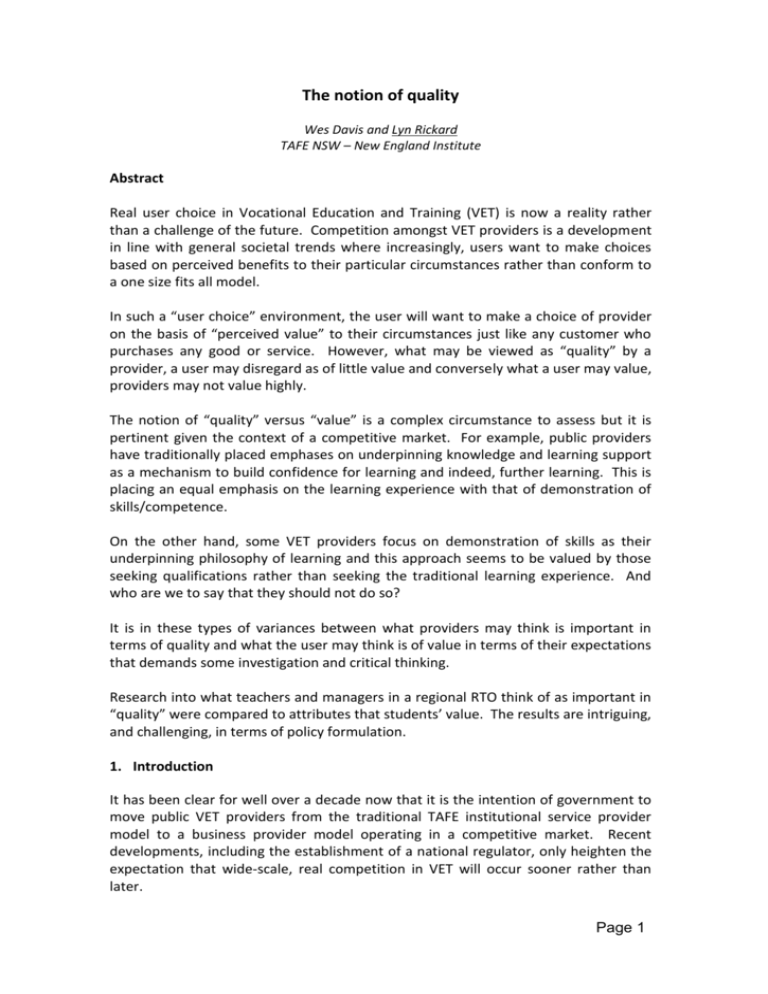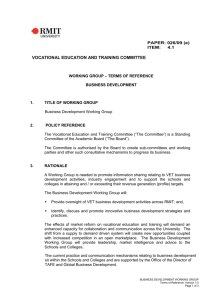The-notion-of-quality-conference-paper-77
advertisement

The notion of quality Wes Davis and Lyn Rickard TAFE NSW – New England Institute Abstract Real user choice in Vocational Education and Training (VET) is now a reality rather than a challenge of the future. Competition amongst VET providers is a development in line with general societal trends where increasingly, users want to make choices based on perceived benefits to their particular circumstances rather than conform to a one size fits all model. In such a “user choice” environment, the user will want to make a choice of provider on the basis of “perceived value” to their circumstances just like any customer who purchases any good or service. However, what may be viewed as “quality” by a provider, a user may disregard as of little value and conversely what a user may value, providers may not value highly. The notion of “quality” versus “value” is a complex circumstance to assess but it is pertinent given the context of a competitive market. For example, public providers have traditionally placed emphases on underpinning knowledge and learning support as a mechanism to build confidence for learning and indeed, further learning. This is placing an equal emphasis on the learning experience with that of demonstration of skills/competence. On the other hand, some VET providers focus on demonstration of skills as their underpinning philosophy of learning and this approach seems to be valued by those seeking qualifications rather than seeking the traditional learning experience. And who are we to say that they should not do so? It is in these types of variances between what providers may think is important in terms of quality and what the user may think is of value in terms of their expectations that demands some investigation and critical thinking. Research into what teachers and managers in a regional RTO think of as important in “quality” were compared to attributes that students’ value. The results are intriguing, and challenging, in terms of policy formulation. 1. Introduction It has been clear for well over a decade now that it is the intention of government to move public VET providers from the traditional TAFE institutional service provider model to a business provider model operating in a competitive market. Recent developments, including the establishment of a national regulator, only heighten the expectation that wide-scale, real competition in VET will occur sooner rather than later. Page 1 Real competition amongst VET providers is a development in line with general societal trends where increasingly, users want to make choices based on perceived benefits to their particular circumstances rather than conform to a one size fits all model. We’ve seen this trend increase in popularity in such sectors as private health insurance, choice of schools by parents and choice of university. User choice in the latter is now firmly established and time will be the judge of the efficacy of that model. The words “VET market” are interesting because they imply that providers can differentiate their products and services in the market place. If all VET providers (public and private) use training package qualifications and associated skill sets then the core products of all providers are identical. All providers will develop different strategies in order to compete effectively. However, some providers may be able to differentiate their products and services from competitors by promoting their tradition and reputation for quality delivery as an enhancement to the product or service. Although that view may be old fashioned enough to be false, tradition may indeed not be a selling point amongst the young, as marketers of products know well. Whilst some may use the concept of “quality” to differentiate products from the products of other VET providers, the user will want to make a choice of provider on the basis of “perceived value” to them just like individuals do when they purchase any good or service. However, that which VET providers may think of as “quality”, a user may disregard as of little value and conversely that which users might value, VET providers may not consider a high priority or even desirable. The notion of user choice where the determinant factor in choice is the user’s perceptions is therefore now a critical matter for consideration. In a competitive market a customer will make a judgement about “value for money”, particularly if a “voucher” system is implemented. And in a competitive environment a provider will make judgements about their competitive advantage, particularly with respect to “quality”. The notion of “quality” versus “value” is a complex circumstance to assess. For example, public VET providers have traditionally placed emphases on underpinning knowledge as a mechanism to build confidence for learning. They believed that this was necessary in order to demonstrate competency in the range of environments specified by the training package. Generally, this is the learning experience provided by traditional service providers and that circumstance, no doubt, will continue to be valued by some industry sectors. On the other hand some VET providers have a different view of “quality” and focus (for example) on demonstration of skills as their underpinning philosophy of learning. This approach seems to be valued by those seeking qualifications in minimum time. Page 2 These folk value the qualification rather than the learning experience. And who are we to say that they should not do so? It is in these types of variances between what public VET providers might think is important in terms of quality and what the user might think is of value in terms of their expectations that require some deeper thinking. There is no doubt that the notion of “quality” is the cliché of these times and nearly every teacher in any TAFE Institute would believe that they contribute significantly to the quality of the Institute. And in many ways they do because they are part of a solid traditional organisation that is known and respected for its quality throughout the community. It is known, for example, that learners do think highly of their learning experience in the main because surveys over the past decade or more have demonstrated that perception is true. But the real issue still remains that traditional VET providers will need to ensure not only customer satisfaction but customer loyalty as well if they are to continue to operate in a competitive environment. In light of these matters a research project was designed to assist the Human and Personal Services (HAPS) Faculty within TAFENSW - New England Institute make strategic decisions with respect to user choice implementation. The project sought inter alia to reconcile some of the perceptions of “quality” from the teaching staff perspective and those of “value”, as held by learners within the faculty. This report deals only with the notion of quality of that research project. 2. Research Method A set of 45 questions were drafted against some of the AQTF Standards and administered via Survey Monkey. Both staff and students were encouraged to complete the survey and approximately 40 from each group responded. Participants were requested to give rankings (0-10) of the importance to them of an attribute to quality and a ranking (0 to 10) of their perceptions of performance. The survey was held open for 4 weeks. Attributes of “quality” were framed around AQTF Standards. Some of these are included in this report. The full set may be made available at a later date. Page 3 2.1 Student survey data (39 responses) TABLE 2.1 Attributes of HAPS which students value the most These are the major expectations of students concerning the service that is provided. They represent the things that students think that they value the most in their learning experience. Attributes Average Rating of Average Rating on Importance Performance Teachers are up to date with industry 9.1 8.6 equipment and methods in training programs and assessment (Q13) TAFE provides a safe learning 8.9 8.7 environment for all learners (Q34) TAFE staff are skilled in designing training 8.9 8.4 programs that industry values (Q4) Teachers can recognise learners with 8.9 8.4 problems and can help them with their learning needs (Q15) TAFE provides the courses that people 8.9 8.4 want (Q35) TAFE provides clear information to 8.9 8.4 learners about the course in which they want to enrol (Q37) Teachers are innovative and they can 8.9 8.3 customise course to suit the individual needs of learners (Q11) Teachers are experienced and they use 8.9 8.2 modern teaching methods to engage and inspire students (Q10) TABLE 2.2 HAPS best performing attributes according to students Students respect staff for these reasons, although the degree of respect is not absolute. It would be ideal if TABLE 2.1 matched TABLE 2.2 exactly and the approval rating was higher. That circumstance would give a real pointer that indeed “value for money” is provided to students. Attributes Average Rating of Average Rating on Importance Performance TAFE provides a safe learning 8.9 8.7 environment for all learners (Q34) Teachers are up to date with industry 9.1 8.6 equipment and methods in training programs and assessment (Q13) Teachers are respected by local industry 8.6 8.6 for their industry knowledge (Q21) Teachers are able to use modern 8.8 8.5 Page 4 learning principles such as working in groups to assist learners (Q17) TAFE teachers are recognised for their 8.7 high standards throughout the community (Q7) 8.5 TABLE 2.3 The largest gaps between the attributes that students value the most and their ranking of HAPS performance These attributes give us a priority list of actions that will add value in the eyes of students. Importance to Quality TAFE is and effective and efficient 8.7 organisation that keeps students informed of their progress (Q42) TAFE provides regular feedback to our 8.7 learners so that they can gauge their progress and ask for assistance if necessary (Q40) TAFE produces high quality learning 8.8 resources for learners (Q31) TAFE has IT services that meet all the 8.6 needs of learners (Q29) TAFE provides information to learners 8.6 so that they are not confused by a complex TAFE system (Q36) TAFE provides our learners with 8.6 sufficient support so that they can complete a course even if they are experiencing difficulties (Q41) Rating of GAP Performance 7.6 1.1 7.7 1.0 7.9 0.9 7.7 0.9 7.7 0.9 7.7 0.9 2.2 Teacher Responses (40 responses) TABLE 3.1 The most important attributes of quality from teachers’ perspectives These are the attributes that HAPS teachers value the most. This is the HAPS teachers’ view of an idealised quality learning environment. Attribute of Quality Average Rating of Average Rating on Importance Performance Teachers should be supportive and 8.8 8.8 readily available to assist learners (Q19) TAFE provides a safe learning 8.5 8.5 environment for all learners (Q34) Teachers can recognise learners with 8.3 8.3 problems and can help them with their learning needs (Q15) Page 5 Teachers are respected by local industry 8.3 for their industry knowledge (Q21) TAFE provides our learners with 8.3 sufficient support so that they can complete a course even if they are experiencing difficulties (Q41) Teachers are innovative and can 8.3 customise courses to suite the individual needs of learners (Q11) 8.3 8.5 8.2 TABLE 3.2 Attributes of quality in which HAPS teachers think that they perform the best These are some attributes for which HAPS teachers say that they have earned respect from students and probably management. They define the attributes, which they say contribute to their claim as a teacher who delivers quality VET. Attribute of Quality Average Rating of Average Rating on Importance Performance Teachers should be supportive and 8.8 8.8 readily available to assist learners (Q19) Teachers nurture the sense of wonder 8.4 8.6 and love of learning in learners (Q20) Teachers can be flexible and change 8.2 8.5 teaching strategies if they are unsuitable for learners (Q18) TAFE provides a safe learning 8.5 8.5 environment for all learners (Q34) TAFE provides our learners with 8.3 8.5 sufficient support so that they can complete a course even if they are experiencing difficulties (Q41) 3. Findings and Discussion There are several dimensions to the research project but the one that is pertinent to this paper is the one of the variances between what students value in a VET learning organisation and what teachers think are the important attributes of quality delivery. TAFE teachers in this faculty say that the most important attributes of a quality VET experience is that teachers should be supportive and recognise when students are having difficulties and provide them with help so that they can complete their course. Students within this faculty say that teachers do not keep them informed of their progress and do not give them enough feedback so that students can make an assessment if they require assistance. Now this is an intriguing issue and could be itself the subject of further research to establish the reasons for these views. But the issue is important in terms of “User Page 6 Choice” because somehow the notions of quality will need to be matched to values of students in the lead up to, and in a competitive VET environment. A component of research deliberations such as this is “knowing the times” because that gives a framework for understanding. In line with that it can be noted that society is very much geared towards a “supermarket culture” where the customer rules. And “User Choice” in the VET context certainly represents that living philosophy. In the “supermarket culture” customers are provided with a range of choices and prices from which they are encouraged to make a choice. The “supermarket culture” from the viewpoint of the consumer can be categorised by the following: I want choices Brand is important I want it now Reward me (give me value) The product should be up to date (product redundancy is not tolerated) It is interesting that although consumers are generally confident and “know what they want” much of the technical detail of any choice is only understood by experts or those who are willing and capable of researching the product. And it is also interesting that despite consumer confidence, advertising still plays an important part in their choice. If “User Choice” really does become significant then these observations about the contemporary consumer mindset will require some consideration There are those who would argue that the mismatch between the expectations of students and teachers is entirely the teachers fault, but that position doesn’t stand scrutiny. The variance often emerges through a lack of congruency between the teacher’s understanding of quality compared with the student. It may be possible however, that a contributing factor to the frustration of those students surveyed is that the expectations brought about by the supermarket culture are not readily achievable in a formal learning environment. Most teachers as individuals writ large of the supermarket culture will have an appreciation of the motivations of VET users but there are factors such as achievement of competency, which cannot be treated extemporaneously. Support in the eyes of a teacher is more about providing a framework of assistance so that real learning can take place. Perhaps in the eyes of some students the concept of support may be a rather plaintive cry for help to be “washed with the learning flannel”. Many experienced VET providers and indeed university teachers would agree that this in increasingly so in the young. Page 7 Whatever the case, it does give some interesting perspectives about the notion of a fully operating “user Choice” model in VET. The mismatches between what providers might want and what students might expect could make for interesting times. 4. Conclusions The notion of quality will be critical factor for providers competing in a new competitive VET environment. The likelihood of a student entitlement scheme reinforces the importance of understanding the needs and values of potential students in order to attract them, and the associated funding to a provider. The ongoing evaluation of student satisfaction will be a critical factor to ensuring repeat business in the new VET environment. Flexibility, adaptation, responsiveness and a willingness and ability to communicate with the student cohort will be qualities required by teachers of the future. 5. Acknowledgements The members of the HAPS Faculty Leadership Team and the broader staff of the Faculty are to be congratulated for their willingness to commence the investigation into the Notion of Quality. The project will continue with further research in 2012. Page 8





